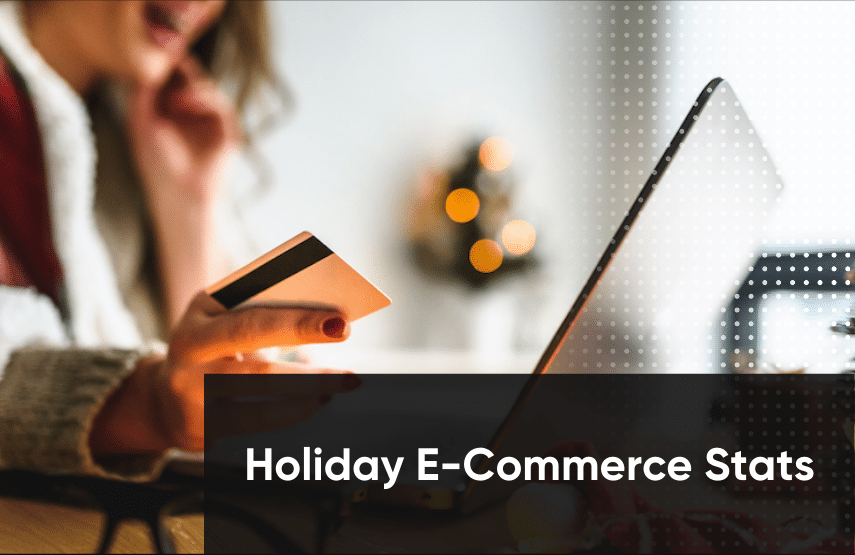2020 Holiday E-Commerce Prep: 31 Online Shopping Statistics

After this chaotic year, many are uncertain if shopping this holiday season will be as big as previous years. While holiday sales, both online and in-person, have steadily grown year over year, a shaky economy, government restrictions, and the health risks of shopping in-person threaten to keep consumers from spending as they have done in the past.
Having analyzed surveys, forecasts, and predictions from a variety of industry leaders, we noticed several trends to expect for the 2020 holiday shopping season:
- Retailers are expecting much lower in-person shopping but are expecting online sales to more than make up for the losses.
- Many are anticipating record online sales, particularly during the Cyber Five promotional period.
- Less traditional fulfillment methods such as buy online, pick up in-store (BOPIS) are expected to grow.
- The increase in online orders may exceed shipping carrier capacity, leading to issues with deliveries.
Additionally, holiday shopping is set to start sooner this year as online retailers are extending promotions to avoid possible fulfillment issues and consumers are wary of product shortages given supply issues earlier this year.
To help prepare you for what is set to be an unprecedented holiday season for online sellers, we have rounded up the top holiday online shopping statistics so you can plan your holiday e-commerce strategy with confidence.
2020 Holiday Online Shopping Statistics
Pre-Holiday Online Shopping Statistics
1. A Gartner survey shows that 46% of consumers increased how frequently they purchased online between March and May 2020.
The outset of the pandemic initiated what could end up being a permanent shift in shopping behavior as many consumers had to turn to online sellers to purchase both essential and non-essential goods.
2. Second and third-quarter e-commerce sales increased by 71% and 55% year over year (YoY), respectively.
The momentum of online sales hasn’t slowed down since physical retailers have begun reopening as online retailers continue to experience record-breaking numbers.
3. Buy online, pick up in-store (BOPIS) grew 259% YoY in August 2020.
According to Coresight Research, nearly 75% of the top 50 store-based retailers in the U.S. are now offering curbside pickup. The convenience of shopping at home combined with quick local pickup is likely to cause a shift in buyer behavior that lasts through the holiday season.
4. Retailers offering BOPIS grew revenue by 27% in Q1 2020.
Retailers that have adopted BOPIS are able to reach a larger customer base by offering a contactless fulfillment method. This is set to continue during the holiday season as more consumers look to avoid stores and traditional online delivery may experience bottlenecks due to increased demand.
5. According to AlixPartners, 49% of consumers plan to start their holiday shopping by Halloween.
Many consumers are looking to avoid the health risks of shopping in-person with large crowds as well as the potential shipping complications from an influx of online orders by beginning holiday shopping earlier. In addition, many retailers are looking to adapt by beginning holiday sales earlier. There is also the added element of Amazon Prime Day taking place in mid-October this year instead of July, which many consumers will have used for holiday shopping.
6. A report from PWC shows that 65% of consumers are concerned about catching the virus when holiday shopping.
Holiday crowds tend to be much larger than other times of the year. Naturally, consumers will give serious consideration to the health risks of visiting stores in-person when it comes time for holiday shopping.
7. Third-party sellers experienced a 60% YoY increase in sales on Amazon Prime Day this year.
Prime Day sales for small and large businesses eclipsed $3.5 billion, a considerable increase from last year. This increase in performance lends credence to the idea that online sales will not experience a drop off this holiday season.
2020 Holiday Shopping Projections
8. CBRE Retail Research forecasts 2020 holiday e-commerce sales to grow by at least 40%
Last year, e-commerce holiday sales grew by 14% to $167.8 billion. With the massive shift to online shopping, CBRE is projecting this year’s growth to more than double that of last year.
9. A 40% growth in online sales will put e-commerce’s share of total retail sales in November and December at 39%.
With more people turning to online shopping channels and fewer people shopping in person, e-commerce will continue to grab a larger share of the total retail market.
10. The Cyber Five promotional period—Thanksgiving day through Cyber Monday— is expected to capture 20.5% of all holiday e-commerce sales.
The popular promotional period beginning on Thanksgiving day is projected to experience slight growth in its share of holiday e-commerce sales. Each promotional day is expected to experience record numbers including Thanksgiving day which is projected to grow by 49.5%, reaching $6.18 billion as many retailers are planning to remain closed on Thanksgiving day.
11. eMarketer projects that Cyber Monday sales will increase by 38.3% from last year.
Online sales are expected to total $12.89 billion which will make this year’s Cyber Monday the biggest online spending day in U.S. history.
12. Black Friday online sales are expected to increase by 39.4% to $10.2 billion.
This will make Black Friday the second biggest online shopping day of the season behind Cyber Monday.
13. Small Business Saturday sales are expected to grow by 35.6% to $4.76 billion
Sales on Small Business Saturday are set to benefit from the increase in online spending as well, with growth projections similar to Cyber Monday and Black Friday.
14. According to the PowerReviews Holiday Consumer Survey, 64% of consumers say they will spend more online than last year.
Retailers can adjust to this shift in behavior by putting more emphasis on their digital channels and ensuring each touchpoint provides a flawless customer experience.
15. According to Deloitte, shoppers anticipate spending an average of $1,387 per household during the holiday season.
This is a slight decrease from last year but many consumers will be redirecting holiday spending from travel to more gift and non-gift items.
2020 Holiday Shopping Preferences
16. A Deloitte survey shows that 60% of people prefer shopping online rather than in physical stores during the holiday season
“Couch commerce” is set to expand as a majority of consumers want to avoid large crowds and prefer the comfort of shopping at home.
17. The same survey found that 53% of shoppers prefer to shop online because they can compare prices.
Shopping online makes it much easier for consumers to weigh their options before making a purchase. You’ll want to make sure to analyze the competition and plan promotions effectively to not miss out on potential sales.
18. App Annie predicts there will be nearly 1 billion hours spent on Android devices in the U.S. during the holiday season, up 50% YoY.
This increase will lead to the biggest holiday shopping season on mobile yet. Retailers should be prepared by ensuring their mobile site offers a frictionless checkout experience.
19. PowerReviews Holiday Consumer Survey reports that 55% of consumers say they will use curbside pickup more this year than they did last year.
BOPIS is becoming a standard expectation for many consumers. Offering a smooth curbside pickup can help businesses stand out during the hectic holiday season.
20. 36% of consumers rate out of stock products as their top frustration during holiday shopping.
Accurately forecasting demand can help prevent missing out on sales and potential long-term customers.
21. 57% of consumers use search engines when they don’t have a particular brand in mind.
Most consumers start their purchase journey with search engines. Optimizing for relevant search terms now can help lead to a boost in traffic as the holiday season picks up.
22. According to Episerver, 52% of Americans start their online holiday shopping on Amazon.
The majority of consumers begin their shopping journey on Amazon and many do not need to leave the platform to find what they’re looking for. If you sell through Amazon, you should look to take advantage of the increased demand by expanding your PPC campaigns and optimizing your listings for search.
23. A Martech Series survey found that 89% of consumers say that they find online advertising important in discovering new products and promotions.
Of the respondents, 31% said that they are more receptive to ads during the holiday season.
2020 Holiday Shipping Statistics
24. The U.S. Postal Service has set a Dec. 15 deadline for its Retail Ground Service to have packages to arrive in the United States before Dec. 25.
Carriers across the country are preparing for the increase in online sales by encouraging consumers to make purchases early enough to allow for a seamless delivery.
25. Salesforce estimates that as many as 700 million packages may not arrive on time due to delays in shipping.
The increase in online orders will likely result in shipping carriers being at capacity. Consider adding a notification to your checkout page so customers are prepared for potential delays.
2020 Holiday Returns Statistics
26. Salesforce estimates there will be around $280 billion worth of returns this holiday season.
With more consumers ordering online, people will have less opportunity to try or see items in person before making a purchase. This will result in a higher number of returns than in previous years.
27. A Narvar study found that 44% of consumers have been more deliberate about what they buy in order to avoid returns.
You can help reduce friction in the buying experience and mitigate the number of returns by ensuring your product descriptions are as informative as possible and that your pictures clearly capture the look of the product.
28. The same study found that 76% of first-time customers that had a pleasant return experience said they would shop at that retailer again.
You can do your best to limit them, but returns are inevitable. By being prepared with an easy and stress-free return process you can win more customers down the road.
How Major Retailers are Preparing
29. Amazon is adding more than 100,000 workers to its fulfillment centers
Amazon expects to be busier than ever as an Episerver report finds that 42% of consumers say they plan to buy most of their holiday gifts from the site.
30. Walmart plans to add 20,000 workers to its fulfillment centers.
The retailer expects to see a significant increase in both online and buy online, ship to store (BOSS) sales as shoppers look to limit in-person shopping.
31. Target plans to hire 130,000 seasonal workers.
Target is expecting a substantial increase in BOPIS sales and says it will be doubling the number of employees dedicated to curbside pickup.
Tech advocate and writer @ fabric.






